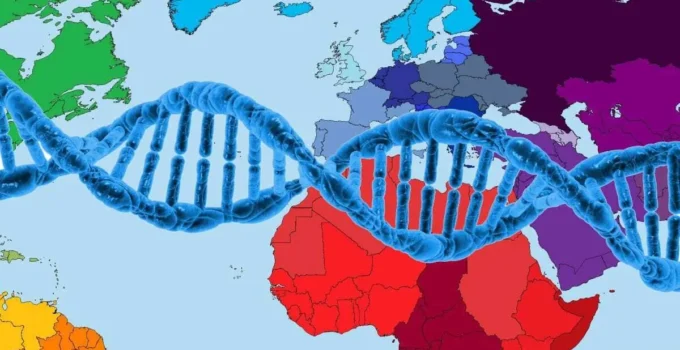Determining an individual’s ancestry and searching for roots through DNA analysis is becoming increasingly popular everywhere in the world. So can your DNA tell where your ancestors are from? The answer is YES! All male offspring have the same Y chromosome – and thus the origin is decoded. But let’s find out a little more about DNA ancestry testing in the text before you.
Revealing Who Our Ancestors Were By Using DNA Analysis
Source: unsplash.com
Want to know where your ancestors come from? It’s not a problem. The answer to this question can be obtained today by analyzing DNA, or more precisely, the male component – the Y chromosome.
Research into the personal genetic background is becoming increasingly popular in the world. We can even say that it is greatly popularized by the famous National Geographic Channel with its TV shows. So it is not surprising that a large number of people have the desire to turn to DNA genetics centers around the world to find out more about their ancestors.
If you have been wondering who are the people who are so interested in this topic, we can say that they are primarily people who want to determine whether they belong to the same lineage. Usually, they want to find out more about their ancestors and make a family tree. Of course, these results can become even more significant when compared to known historical knowledge about a particular family.
How Is DNA Origin Determined?
In most cases, people are particularly interested in determining the geographical origin of an individual. Determining the primordial origin consists in extracting the male component – that is, the Y chromosome, from DNA.
This chromosome is transmitted exclusively from father to son, so all descendants in the male line have the same Y chromosome – for example, grandfather, father, sons, uncles, etc. After that, the so-called Y haplotype should be determined.
Then, that Y haplotype is compared with the existing base of Y haplotypes in the world – and we can find the same or the closest one. How unexpected these findings can be is best evidenced by the results obtained in numerous genetic centers. In these places, clients from all around the world found their ancestors in distant places – such as northern Russia and Siberia, or ancient countries such as Persia, Galicia, etc.
Can We Determine Our Ancestors By A Female DNA?
Source: unsplash.com
Since the origin is usually determined by tracing the male line and the Y chromosome – many people are wondering if we can do the same by using female DNA. Tracking the origin of the female line is generally something geneticists don’t do – because it is a far more demanding procedure.
But, we have to clarify one important thing about it. Namely, the female line does not transmit specific DNA only from mother to daughter like in the case of the Y chromosome. It is something that a mother passes to all of her children regardless of gender – while in men, according to the Y chromosome, it is only from the father to son.
The Principle On Which The DNA Ancestry Test Work
So what do geneticists actually do in this procedure? According to CRI Genetics, the client first gives a sample, after which a list of characteristics of his Y chromosome is obtained – and then it is compared where the same Y chromosome was found in the world. However, the perfect match is not always found in all situations.
The databases used by geneticists are large – but still not enough to give you answers every time. However, in most cases, certain matches can satisfy your curiosity. Then, for example, the client can find out that the same Y chromosome exists, say, in the Urals.
This is not absolute proof that his distant ancestor came from the Urals – but there are great chances that he once immigrated from that area to the region where the client lives now.
Determination Of DNA Origin
Source: theguardian.com
Determination of DNA origin, that is, the DNA ancestry test, is based on the analysis of tens of thousands of DNA markers that are compared with reference populations and gene pools. These extensive data are further processed bioinformatically – to give the algorithm the most accurate biogeographic results available.
This allows you to follow your DNA even to 1,000 years backwords, to the area where your unique DNA signature, or seal, was conceived. The geneticists use global gene poles to determine the genetic seal of your autosomal DNA. Then it compares your unique DNA profile to more than 1,000 populations around the world – to find where your personal DNA profile originated.
How To Provide A DNA Sample?
To do such an analysis, it is enough to take a swab from the inside of the cheek. Many people wonder why from that place in particular? The answer is simple – because it is the easiest way to do it. The DNA molecule is the same in every cell of our body – and it is easiest to rub a stick on the inside of the cheek. No needles, no required blood samples -no pain, just gain. So this is actually the simplest element in this entire story.
The Accuracy Of Such DNA Test And How Many Generations Can We Determine Backwards
Source: unsplash.com
Geneticists claim that it is not possible to determine with complete accuracy how many generations of one’s ancestry can we find. This is not an infinite search because DNA changes from time to time. But those aren’t such big changes – at least not so much that you can’t keep up with them for hundreds of years in the past.
Mutations occur once in a hundred cases, both vertically and horizontally. In some generations, the DNA remains so altered – while in some cases the DNA changes but later returns to its original state – so a 100% accurate estimate cannot be given. In general, it is possible to go back 250 or even 1000 years, but in biology, nothing is so exact – geneticists claim.




